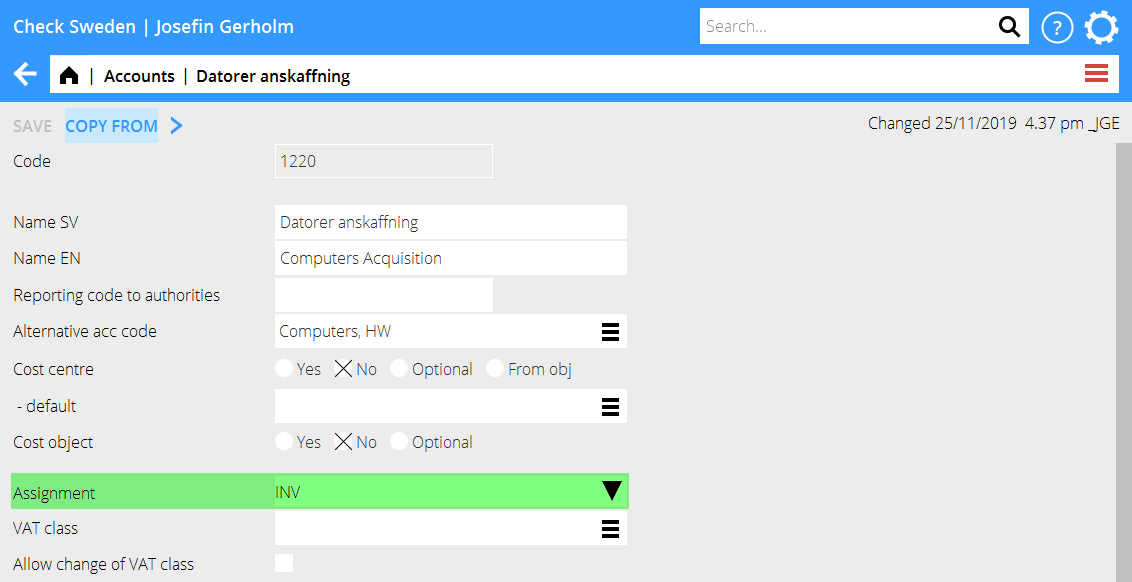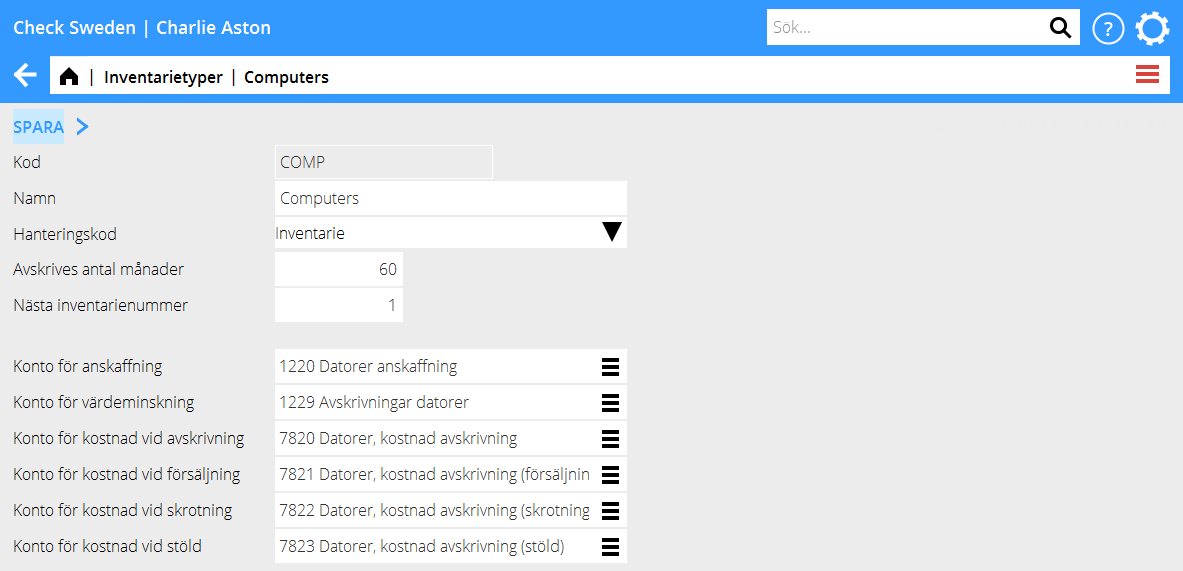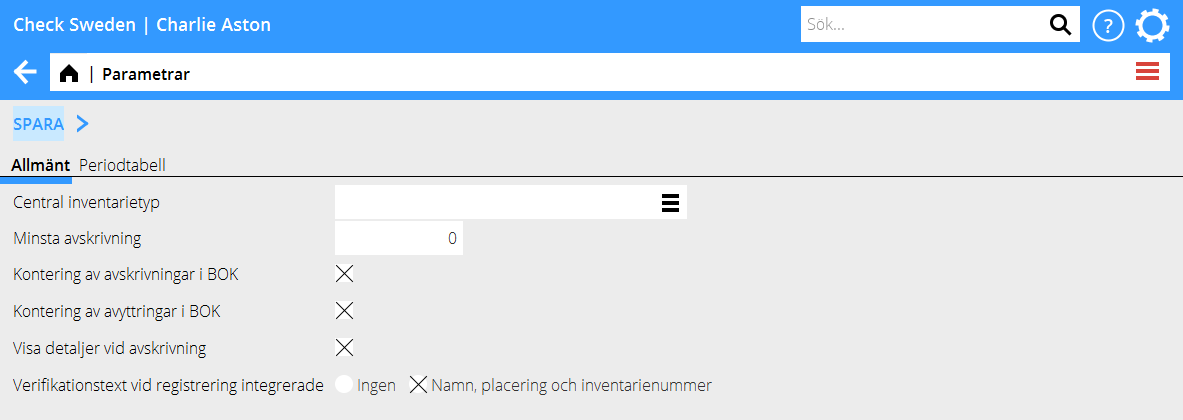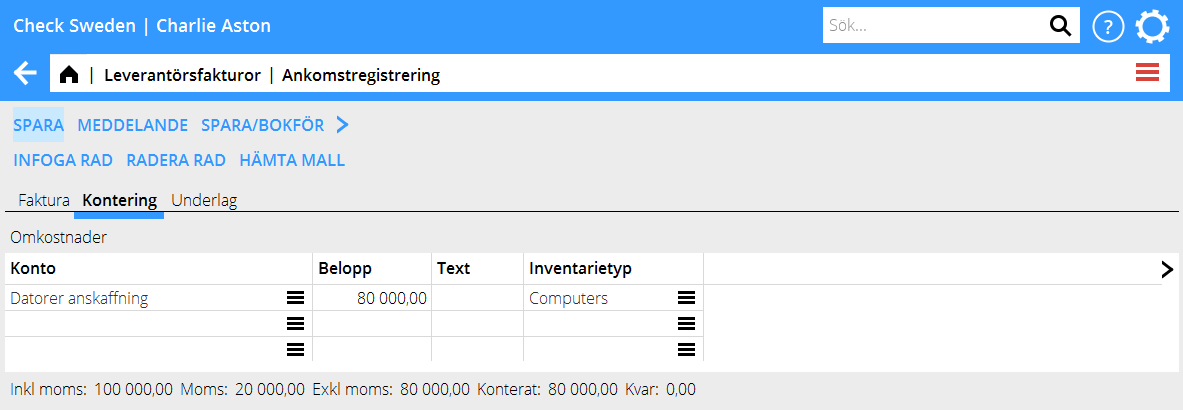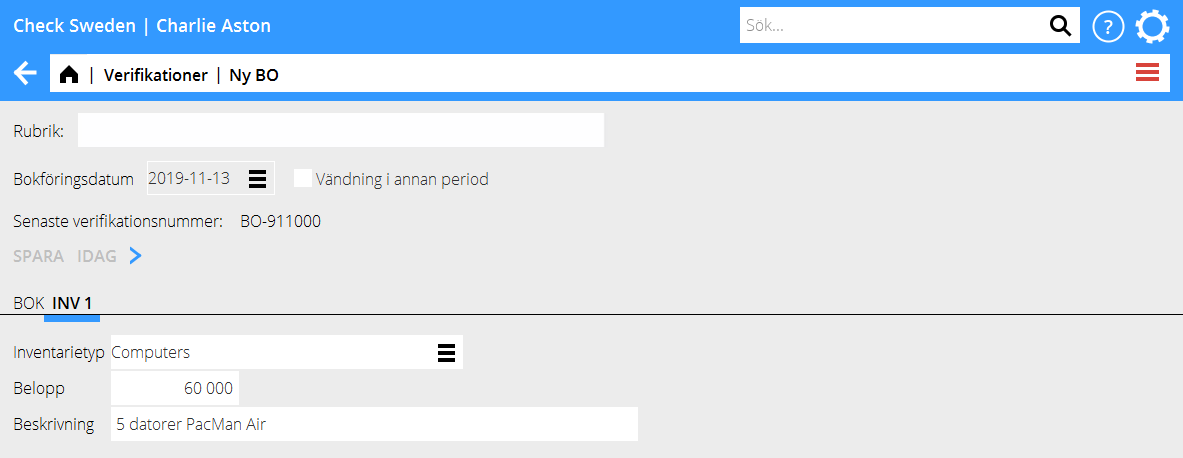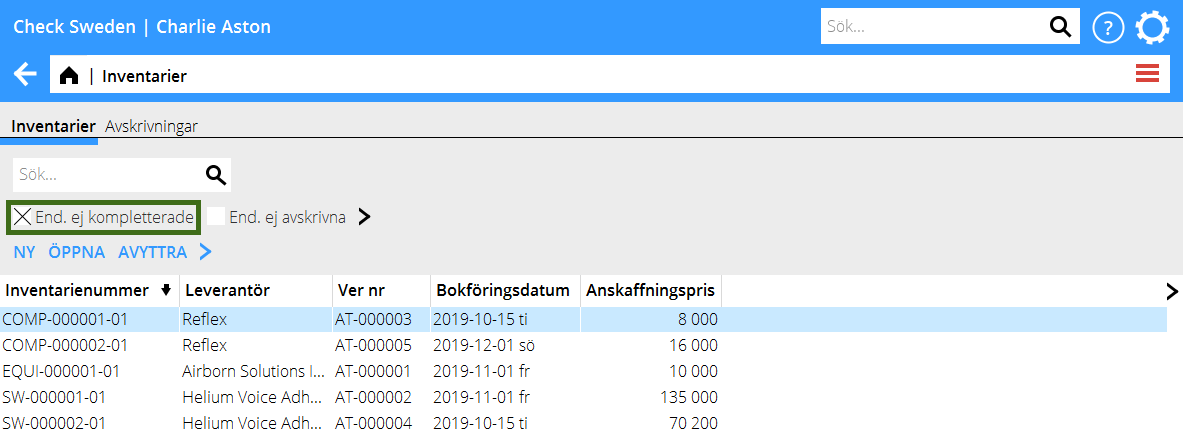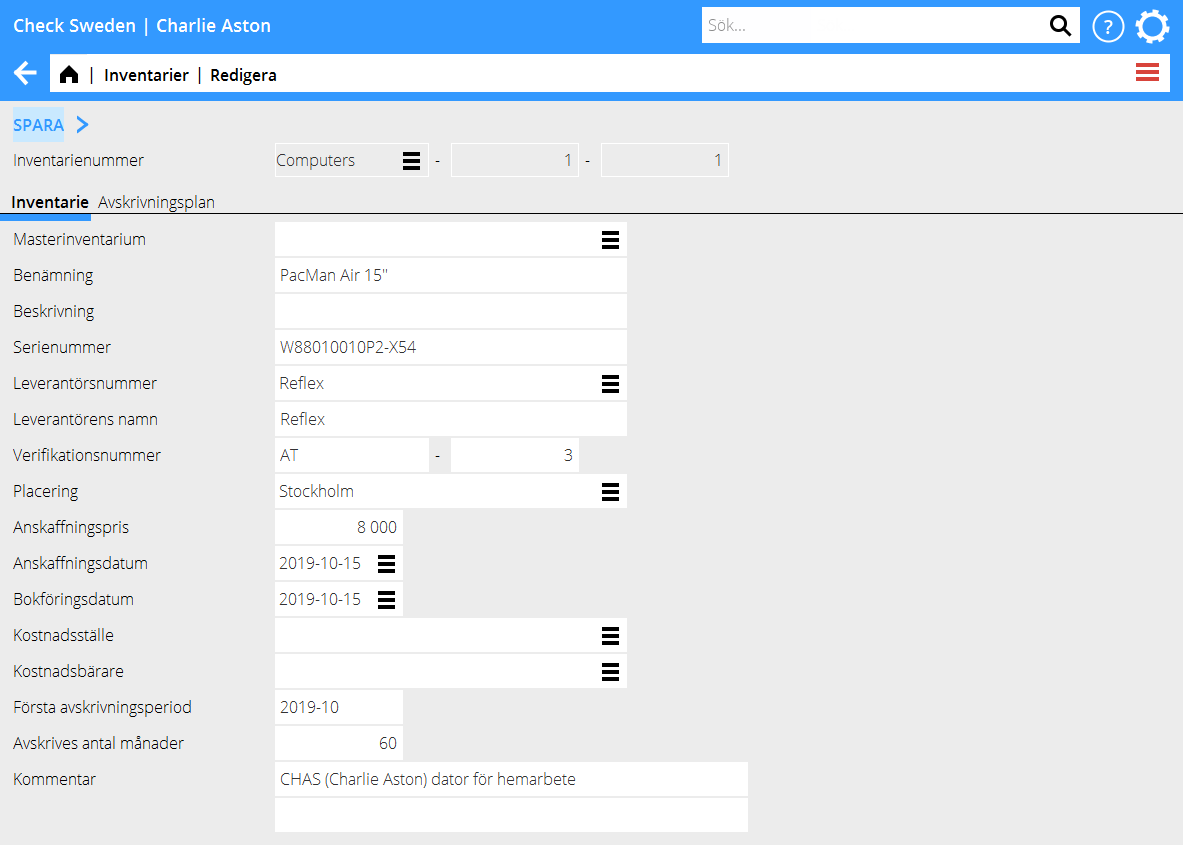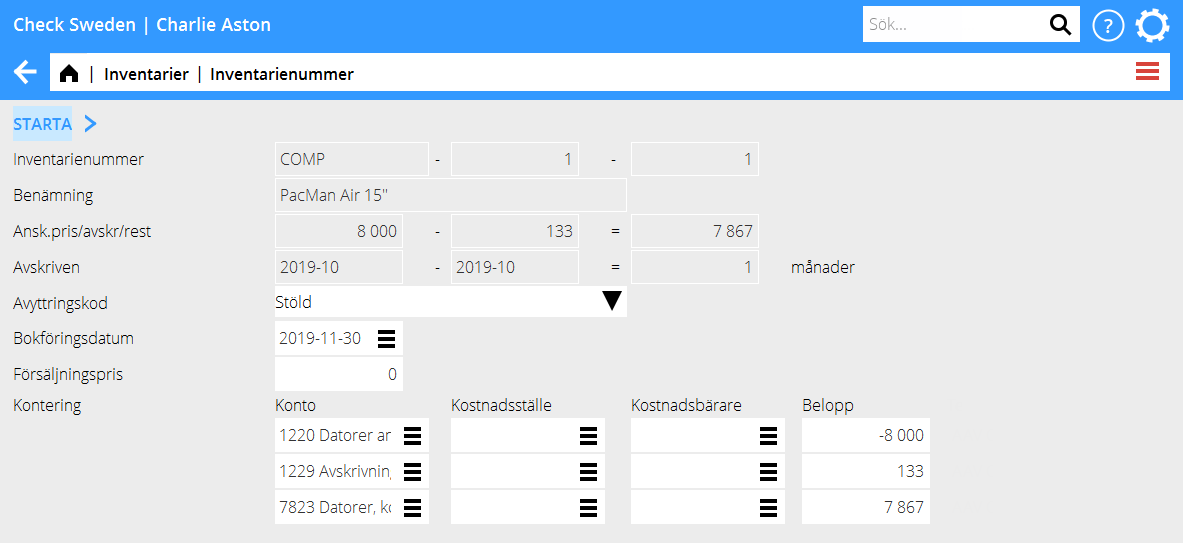Inventaarit
Contents
Inventaarit Marathonissa
Inventaarit on erillinen reskontra Marathonissa yrityksen irtaimen omaisuuden hallinnoimista varten. Se on integroitu taloushallintoon; inventaarit syötetään järjestelmään joko ostolaskuina tai erillisinä tositteina ja poistot ja luovutukset tiliöidään kullekin inventaarilajille asetetulle tilille.
Asetukset ja perusrekisterit
Muutama asetus Marathonissa koskee inventaarioiden käsittelyä.
intregraatiot tileillä
Hankintatilien on oltava integroituna inventaarireskontraan, jotta kirjanpidosta ja ostolaskuista tulleet inventaarit saataisiin rekisteröityä. Avaa hankintatilit tilikartassa Järjestelmä: Perusrekisterit/KP/Tilit. Kentässä integraatio, valitse INV.
Inventaarilajit
Jokaisen inventaarin on kuuluttava inventaarilajiin Marathonissa. Se ohjaa tiliöintejä poistojen yhteydessä ja ehdottaa poistokuukausien määrän. Se auttaa myös kategorisoimaan eri inventaareja. Lajit rekisteröidään ohjelmassa Järjestelmä: Perusrekistreit/INV/Inventaarilajit.
| Koodi | voi olla enintään neljä merkkiä pitkä ja on yleensä lyhennys inventaarista, esim TIET Tietokoneelle. |
|---|---|
| Käsittelykoodi | ohjaa inventaarilajin poistosääntöjä:
Inventaari on tavallisin käsittelykoodi; näitä inventaareja voi poistaa ja luovuttaa automaattisilla tiliöinneillä. Laitevuokra eli leasing ei johda poistoihin vaan viedään heti menoksi. Menotililtä laskutettu voidaan käyttää kun rekisteröidään inventaarioita, jotka viedään heti hankinnan yhteydessä menoksi. Kustannusarviolla voi budjetoida inventaariot. Inventaareihin liittyvillä raporteilla on mahdollista tehdä valikoimia käsittelykoodien avulla. |
| Poistetaan - kuukausimäärä | ehdottaa inventaarilajille sopivaa poistoaikaa. Lukumäärää voi muuttaa. |
| Seuraava inventaarinumero | näyttää seuraavan inventaarin tulevan numeron. Numero on muodossa XXXX-NNNNNN-NN jossa XXXX on inventaarilajikoodi, NNNNNN sarjanumero viimeiset NN alisarjanumero, esim.: TIET-000001-01 |
| Numerosarja | voi olla eri eri inventaarilajeille. Voit käyttää yhteistä numerosarjaa yhdelle tai usealle inventaarilajille. Jos yleinen numerosarja on käytössä, seuraava inventaarinumero on oltava 0. |
| Tili hankinnoille | käytetään uusien inventaarien ja luovutusten rekisteröinnissä. Hankinnan yhteydessä koko inventaarin kustannus veloitetaan. Kun se myydään, koko määrän hyvittämistä ehdotetaan, muta sitä voi muuttaa. |
| Tili arvonalennuksille | käytetään poistoissa ja luovutuksissa. Poiston yhteydessä määrä hyvitetään. Myynnin yhteydessä, koko aikaisemmin poistettua määrää ehdotetaan. |
| Tili poistokustannuksille | käytetään poistoissa. Poistoja tehtäessä veloitetaan poistojen kokonaismäärä. Myynnin yhteydessä ehdotetaan, että aiempien poistojen kokonaismäärä veloitetaan. |
| Tili myyntikustannuksille | käytetään myynnissä. Myynnin yhteydessä ehdotetaan veloitettavaksi jäljelle jäävä määrä. |
| Tili romutuskustannuksille | käytetään inventaarien romutuksessa |
| Tili varkauskustannuksille | Käytetään, mikäli inventaari varastetaan |
Suosittelemme käyttämään erillisiä tilejä kullekin inventaarilajille ja tiliöintilajille-
Sijoituskoodit
Sijoituskoodien avulla voi kytkeä inventaareja eri osastoihin, esim toimistoihin tai talokerroksiin. Sijoituskoodit rekisteröidään ohjelmassa Järjestelmä: Perusrekisterit/INV/ Sijoituskoodit ja vaativat vain koodin ja nimen.

Parametit
Inventaarireskontraa koskevat parametrit löytyvät ohjelmasta Järjestelmä: Perusrekisterit/INV/ Parametrit. Yleinen inventaarilaji on määriteltävä, jojokin inventaarinumero kuuluu ylsieiseen numerosarjaan. Kaikki inventaarilajit, jolla seuraava inventaarinumero on 0, käyttävät yleistä numerosarjaa. Tässä ilmoitettua numerosarjaa käytetään inventaarilajilla. Parametrit Poistojen tiliöinti KP:ssa ja Luovutusten tiliöinti KP:ssa määräävät, tiliöidäänkö poistot ja luovutukset automaattisesti kirjanpitoon tai ei. Ilman parametrin aktivointia ne on tiliöitävä käsin, jotta inventaarireskontra ja kirjapito täsmäävät.
Inventaatien rekisteröinti
Inventaareja voi rekisteröidä kolmessa eri ohjelmassa.
Ostoreskontran kautta
Mikäli inventaari tulee ostolaskulta, voit rekisteröidä sen laskun tiliöinnin yhteydessä. Ilmoita hankintatili inventaarille. Jos vain yksi inventaarilaji on kytketty tilille, lajia ehdotetaan kentässä Inventaarilaji. Jos lajeja on useita, kenttä on täytettävä manuaalisesti.
Kirjanpitotositteen kautta
Ilmoita inventaarin hankintatili. Välilehti INV ilmestyy. Ilmoita siihen Inventaarilaji, Määrä ja Nimi. Palaa välilehdelle KP ja täydennä tiliöinti ja tallenna.
Manuaalisesti
Voit rekisteröidä inventaareja suoraan inventaarireskontraan. Käsin tehty rekisteröinti täytyy myös kirjata manuaalisesti, jotta osajärjestelmät täsmäisivät. Rekisteröi ohjelmassa Taloushallinto: Inventaarit, paina New.
Täydennä inventaareja
Jos inventaari on viety järjestelmään ostolaskun tai tositteen kautta, se on täydennettävä ohjelmassa Taloushallinto: Inventaarit, välilehdellä Poistot. Rastita ruutu Vain täydentämättömät nähdäksesi listan täydentämättömistä.
Avaa inventaari ja ilmoita ainakin Ensimmäinen poistokausi. Voit kirjoittaa myös muita täydentäviä tietoja, kuten sarjanumeron, sijoituspaikan ja kommentin.
Poistot
Poistot tehdään kohdassa Taloushallinto: Inventaarit, välilehti Poistot. Kirjoita Kauteen ja kirjauspäivämäärä. Voit valita, että poistot tehdään vain tietyntyyppisistä inventaareista. Jos jätät kentän tyhjäksi, kaikki inventaarilajit otetaan mukaan. Voit aloittaa tekemällä koetulostuksen, jotta saat luettelon siitä, mitä poistot sisältävät ja miten kirjaukset tulevat olemaan. Kun olet tarkistanut, että se näyttää oikealta, poista rasti Koetulostus -kohdasta ja tulosta.
Luovutus
Voit luovuttaa inventaarin siirtymällä Taloushallinto: Inventaarit, välilehti Inventaarit. Valitse inventaari ja paina Myy. Valitse koodi, joka vastaa luovutuslajia ja kirjauspäivää. Jos luovutus johtuu myynnistä, syötä myös Myyntihinta. Luovutuksen tiliöinnin ehdotetaan perustuvan inventaarin jäljellä olevan määrään, mahdollisen myyntihintaan ja inventaarilajiin tileihin. Tiliöinti voidaan korjata manuaalisesti.Kun tiliöinti on valmis, paina Aloita.
Inventaarin jako
Jos haluat jakaa inventaarin moneen osaan, tee valinta ohjelmassa Taloushallinto: Inventaarit, ja paina Jaa. Rekisteröi nimi, sijoitus ja hankintahinta taulukkoon, yksi rivi per inventaari.
Kaikki jaetut inventaarit saavat saman päänumeron, mutta eri alinumerot. Esimerkiksi, iventaari COMP-1-1 joka jaetaan kahteen saa numerot COMP-1-1 ja COMP-1-2.
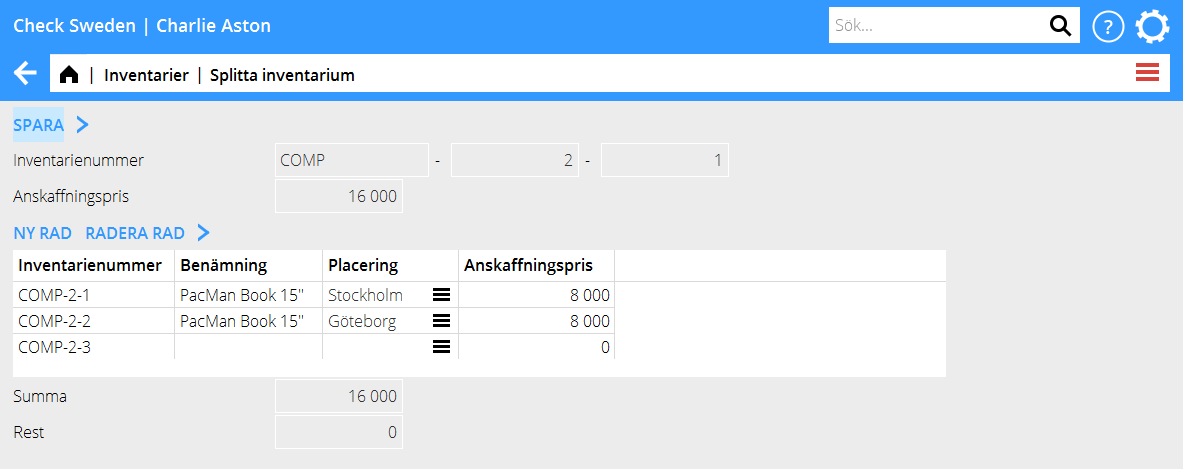
Muuta inventaarinumeroa
Jos sinulla on inventaari, joka on jostain syystä päätynyt väärään inventaarilajiin tai saanut väärän numeron, voit korjata sen Taloushallinto: Inventaarit, välilehti Inventaarit. Valitse inventaari ja paina Vaihda numero ja kirjoita numero, johon inventari siirretään. Huomaa, että kirjanpito on korjattava manuaalisesti, jotta osajärjestelmät täsmäisivät.
Muokkaa poistosuunnitelmaa
Omaisuuserät poistetaan kiinteällä poistosuunnitelmalla, Hankintahinta/Poistokuukausien lukumäärä.Esim. 60 000 SEK arvoisesta inventaarista, joka poistetaan 60 kuukaudessa, tehdään siis 1000 SEK kuukausipoistot. Poistosuunnitelmaa voidaan muuttaa kahdella tavalla.
1.Muokkaa poistosuunnitelmaa (vain tulevien poistojen korjaaminen)
Jos haluat muuttaa inventaarin jäljellä olevan määrän poistotahtia, avaa inventaari kohdassa Taloushallinto: Inventaarit, välilehti Inventaarit, välilehti Poistosuunnitelma. Ilmoita korjauskuukausi kenttään Kaudesta. Sarake Kauteen jätetään normaalisti tyhjäksi; uusi suunnitelma koskee siis kaikkia tulevia poistoja. Uusi poistosuunnitelma on voimassa sen jälkeen, kun kentässä Kaudesta on ilmoitettu kuukausi. Tämä ei vaikuta jo tehtyihin poistoihin. Esimerkki: Hankintahinta 60 000 SEK. Ensimmäinen poistojakso 01-2019. Poistettavat kuukaudet = 60. Suoritetut poistot alkaen 12-2019 . Uusi poistosuunnitelma kaudesta 01-2020 alkaen, poistokuukaudet = 12. Vuoden 2019 aikana on tehty 12 poistoa 1 000 SEK /kk. Jäljellä oleva määrä vuoden 2019 jälkeen = 48 000 SEK. Poistot 01-2020 ja siitä eteenpäin ovat 5 000 SEK (60 000 kruunua / 12).
2.Muokkaa kuukausia (korjaus takautuvasti)
Jos inventaarin poistosuunnitelma on virheellinen ja haluat korjata myös jo tehdyt poistot, voit muuttaa kuukausia suoraan inventaaris Taloushallinto: Inventaaritt, välilehti Inventaarit. Seuraava poisto korjaa aiemmat poistot uuden kuukausimäärän perusteella. Esimerkki: Hankintahinta 60 000 SEK. Ensimmäinen poistojakso 01-2019. Poistokuukaudet = 60. Suoritetut poistot 12-2019. Muutos kentässä Poistokuukausia inventaarilla = 24, mikä tarkoittaa 2 500 SEK kuukausittaisia poistoja. Vuoden 2019 aikana on tehty 12 poistoa 1 000 SEK/kk = 12 000 SEK. Vuonna 01-2020 on tehty 20 500 SEK poistot. 2 500 SEK 01-2020 ja 18 000 SEK, joka korjaa vuoden 2019 aiemmat poistot (60 000 / 24 * 12 - 12 000).
Raportit
Inventaarioreskontran raportit löytyvät kohdasta Taloushallinto: Raportit, välilehti Inventaariot.
Raportti Luettelo poistoista on vakioraportti, jossa luetellaan poistojakson, kirjauspäivän ja Inventaarilajin mukaan valitut inventaarit.
Raporttia Raportit käytetään raporttien tulostamiseen räätälöidyillä sarakemalleilla.
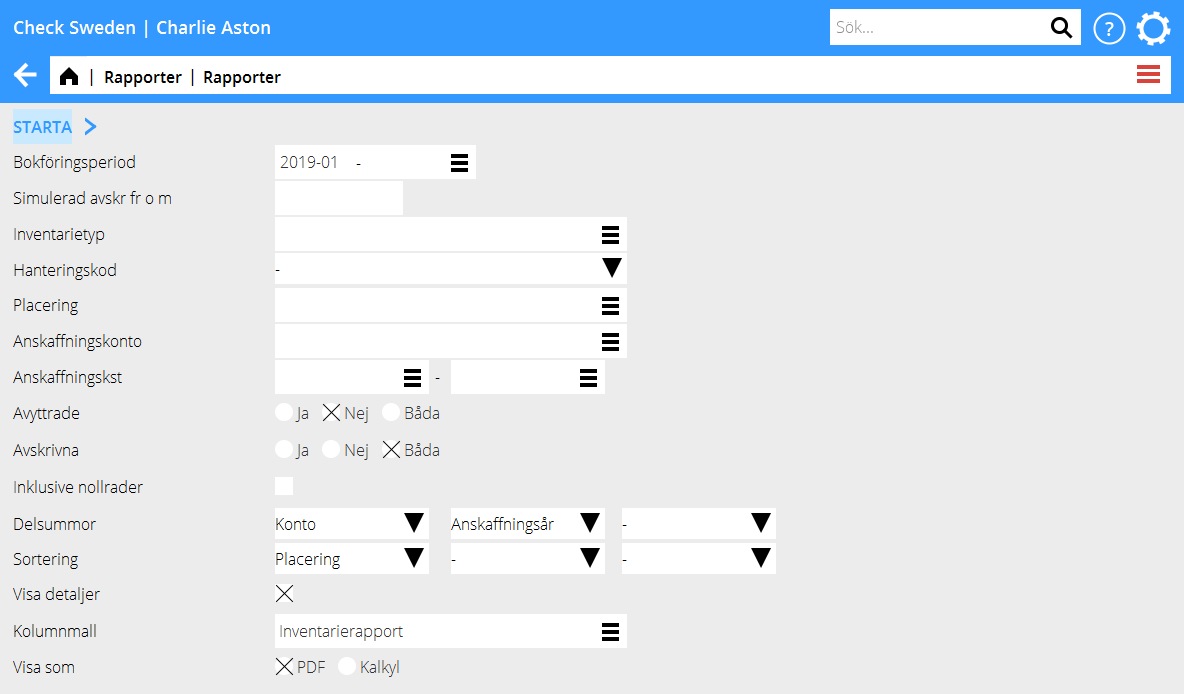
[Category: Accounting] [Category: ACC-INV-EN] [Category: Manuals]
